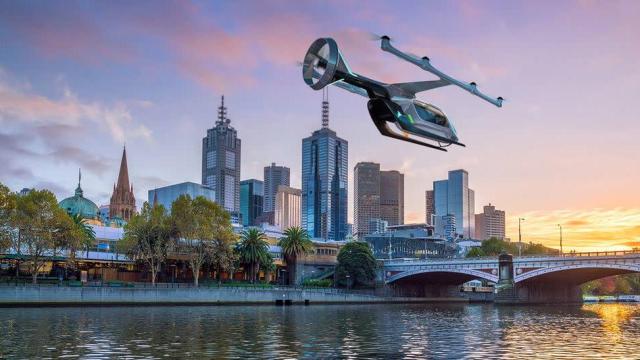Look out, because Uber has an airborne bridge it wants to sell you.
The ridesharing giant announced that Melbourne, Australia will join the cities of Dallas and Los Angeles for tests of its “aerial ridesharing,” “electric vertical takeoff” Uber Air service at its third annual Uber Elevate event on Tuesday, the Guardian reported, with test flights scheduled for next year and a target launch date of 2023.
Per TechCrunch, Uber Elevate chief Eric Allison claimed at the event that the company’s “vision is that on a daily basis it’ll be more economically rational for you to fly than for you to drive.” Allison added that the company believes Uber Air will be as cheap as an Uber X or Uber Pool in the near term, and once it goes fully electric and autonomous, will be more economical in the long term than owning a car, TechCrunch wrote.
Right. OK.
Uber also debuted designs for the interior of its air taxis at the event, which it wants to “become a widely accepted standard for eVTOL [electric vertical take-off and landing] vehicle rider experience.”
It also introduced a number of designs for what it calls “skyports,” which more or less resemble fancy parking garages and/or malls with helipads on the roof.
This all sounds totally credible! It’s not like flying cars have been repeatedly promised to be just around the corner for decades, or that Uber’s partners appear to be very far off from launching anything.
(Bell says no earlier than 2025; Boeing’s was reportedly nowhere close to mass production earlier this year; Embraer is still doing concept design; Jaunt Air Mobility was founded last year; Pipistrel Vertical Solutions has been flying various test vehicles but declined to provide details to AVweb; etc.)
Uber did launch a service called Uber Copter last week to fly rich people back and forth from Manhattan to JFK, and in a ludicrous chart posted by TechCrunch, explained that it will be relying on regular old helicopters piloted by people before eventually going autonomous at scale. So that appears to be the short-term strategy.
But as Fast Company noted, there are already competing helicopter-rental services like Blade and Voom, and potentially more profitable electric VTOLs of the kind that Uber says will make up its air taxi fleet could take 10 years to hit the air after they’re designed:
“Generally, it takes 10 years to certify a new type of aircraft,” says Mike Hirschberg, an aeronautical engineer and executive director of the Vertical Flight Society (formerly the American Helicopter Society). And that’s for new designs based on well-known technologies. Uber and partners say they can get their futuristic craft approved in five years or less.
That’s in addition to getting dozens of vertiport construction projects through zoning approvals and built–and past citizen groups up in arms about increased noise and traffic. (Even eVTOLs are not silent. They make a buzzing sound rather than the “whoosh” of a helicopter.) Add onto that the challenge of securing electrical supply for round-the-clock charging of the planes’ massive lithium-ion batteries.
Obtaining Federal Aviation Administration for any kind of mass rollout of the technology will also be extremely time-consuming, with issues ranging from airspace restrictions to air traffic control to sort out.
“These are truly some of the most exciting developments in aerospace since the Wright Brothers,” Acting FAA Administrator Dan Elwell told attendees at Elevate, according to CNN.
“[But] I put on my FAA regulatory hat and I got a whole new bucket of stuff to worry about. I see car-sized vehicles with multiple rotors hanging over dense urban populations.”
Uber has also touted driverless cars as a similarly incredible technology that will allow it to reverse its ongoing cash haemorrhage of billions a year. But despite dumping hundreds of millions of dollars into the technology, Uber recently admitted that it is going to take quite a long time for them to deploy the technology at scale.
That cash haemorrhage continues unabated, by the way. As New York Mag pointed out last year, Uber has mainly narrowed it by squeezing drivers of their revenue and “been frantically adding new business like Uber Eats and scooter rentals to keep its growth story alive.” Hmm.
There’s also the unsettling implications of giving a company that has a pretty poor record on safety and flipping the bird to regulators a fleet of flying vehicles—as well as a company with a bad record on traffic congestion the ability to experiment with clogging the skies with aircraft).
the good news: the upper half of my body was sheared off (only my legs are left) by the rotor of an Uber Air vehicle that crashed into my living room while I was watching TV
the bad news: the pilot effectively made $7 an hour after accounting for maintenance costs— thomas violence (@thomas_violence) June 12, 2019
Listing the challenges last year—ranging from inadequate present-day battery and electric-flight technology and the sheer volume of passengers Uber claims will be flowing through these skyports to the fact autonomous passenger flight systems remain in the realm of science fiction—the Drive dubbed the Uber Air plan a “delusional fantasy” that would not “pass scrutiny in any competent VC boardroom” were it not for magical thinking.
But don’t worry, Uber and AT&T added 5G to the mix on Tuesday, so you can be totally confident that they’re not just throwing around concept art and buzzwords.
